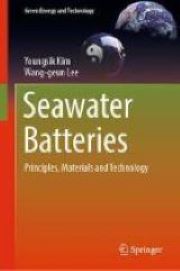Seawater Batteries
Publisher Springer
Date 2022.05
Batteries are a significant source of energy in modern life, with applications ranging from small devices to electronic equipment, electric vehicles, auxiliary power devices, and energy storage systems. This scalability was enabled in particular by the development of secondary batteries, the performance of which has been continuously enhanced over decades to make them capable of storing and supplying higher power. However, such a rapid growth in battery demand inevitably raises worries about the sustainability of energy resources, particularly lithium and metals. This is why, despite the enormous success of lithium-ion batteries, research is being conducted on next-generation batteries that use less expensive and more ecofriendly post-lithium materials.
Sodium is perceived as a sustainable energy storage medium due to its accessibility. In this perspective, a seawater battery that stores energy utilizing sodium ions in seawater is one of the most promising technologies as it directly exploits sodium ions included inside the semi-infinite seawater, the world’s most plentiful resource. Additionally, it is acknowledged as one of the most appropriate batteries for use in a variety of marine devices, machines, and ships that operate in a marine environment. Unlike other batteries, however, the rigorous and systematic research and development necessary to implement the seawater battery was initiated until lately. This is attributed to the irony that abundant and environmentally friendly seawater is difficult to handle mechanically and electrically. This necessarily implies research into seawater-resistant materials, robust energy storage/production architecture, and detailed charging/discharging controls. Due to these difficulties, seawater battery development has concentrated on primary batteries for specialized applications such as military or communication during the last few decades. The rechargeable secondary seawater battery was just recently demonstrated and produced. Secondary seawater batteries, as an environmentally friendly and sustainable sodium-based
power supply device, are expected to be used in a wide range of applications, not just in maritime equipment and devices, but also in coastal and inland areas.
The purpose of this book is to provide an overview of these seawater battery technologies. Accordingly, this book introduces the characteristics of seawater as an energy resource, and then deals with the materials, principles and technology of the first developed primary seawater battery, and the recently researched and developed secondary seawater battery. In Chapter 1, we tried to describe the value of seawater as the next-generation resource and energy materials, as long as a circulation medium of the earth’s energy and resources system. In Chapter 2, we tried to help the understanding of the primary seawater battery for special purposes by examining the development process of the primary seawater battery and examining various materials, operating principles, and cell design. In Chapter 3, the characteristics and operating principles of each part of the recently implemented secondary seawater battery, as well as the latest research on cell development, were to be explained in relatively detail. Through this book, it is expected that readers would get a general understanding of seawater batteries, but also develop an integrated understanding of materials exploration, cell design, and electrochemical in research and development of batteries. Furthermore, we hope that this book will not only provide clues to the energy resource problems facing mankind, but also contribute to suggesting technological directions for a more prosperous sustainable society.
Sodium is perceived as a sustainable energy storage medium due to its accessibility. In this perspective, a seawater battery that stores energy utilizing sodium ions in seawater is one of the most promising technologies as it directly exploits sodium ions included inside the semi-infinite seawater, the world’s most plentiful resource. Additionally, it is acknowledged as one of the most appropriate batteries for use in a variety of marine devices, machines, and ships that operate in a marine environment. Unlike other batteries, however, the rigorous and systematic research and development necessary to implement the seawater battery was initiated until lately. This is attributed to the irony that abundant and environmentally friendly seawater is difficult to handle mechanically and electrically. This necessarily implies research into seawater-resistant materials, robust energy storage/production architecture, and detailed charging/discharging controls. Due to these difficulties, seawater battery development has concentrated on primary batteries for specialized applications such as military or communication during the last few decades. The rechargeable secondary seawater battery was just recently demonstrated and produced. Secondary seawater batteries, as an environmentally friendly and sustainable sodium-based
power supply device, are expected to be used in a wide range of applications, not just in maritime equipment and devices, but also in coastal and inland areas.
The purpose of this book is to provide an overview of these seawater battery technologies. Accordingly, this book introduces the characteristics of seawater as an energy resource, and then deals with the materials, principles and technology of the first developed primary seawater battery, and the recently researched and developed secondary seawater battery. In Chapter 1, we tried to describe the value of seawater as the next-generation resource and energy materials, as long as a circulation medium of the earth’s energy and resources system. In Chapter 2, we tried to help the understanding of the primary seawater battery for special purposes by examining the development process of the primary seawater battery and examining various materials, operating principles, and cell design. In Chapter 3, the characteristics and operating principles of each part of the recently implemented secondary seawater battery, as well as the latest research on cell development, were to be explained in relatively detail. Through this book, it is expected that readers would get a general understanding of seawater batteries, but also develop an integrated understanding of materials exploration, cell design, and electrochemical in research and development of batteries. Furthermore, we hope that this book will not only provide clues to the energy resource problems facing mankind, but also contribute to suggesting technological directions for a more prosperous sustainable society.

